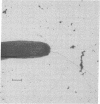Abstract
Myxococcus xanthus, an organism whose motility involves cell interactions, normally bears pili. Myxococcal pili are found only at cell poles, are less than 10 nm in diameter, and may be longer than a cell. Myxococcus has two basic patterns of cell movement, adventurous (A-motility) and social (S-motility). Pili are found to be completely correlated with the presence of S-motility. (The S-motility pattern has many groups of cells, almost no single cells, and is governed by a set of genes called system S.) On the other hand, A-motility is in dependent of piliation. (The A-motility pattern has many single, isolated cells and it is governed by a second set of genes called system A.) Electron microscopic examination of more than 40 genetically different strains shows that all A+S+ (wild-type) and A-S+ strains have pili, but A+S- and A-S- strains lack them. Mutations in four different loci belonging to system S were tested and were found to stop productions of pili: the loci sg1A, sg1B, sg1G, and tg1. When brought into contact with tg1+ cells, cells of a tg1- strain, which lack pili, become phenotypically S+, produce pili, and become S-motile. Both motility and the production of pili are transient when initiated in this way. Thus it appears that pili permit cells that are close to one another to move.
Full text
PDF




Images in this article
Selected References
These references are in PubMed. This may not be the complete list of references from this article.
- Burchard R. P. Gliding motility mutants of Myxococcus xanthus. J Bacteriol. 1970 Nov;104(2):940–947. doi: 10.1128/jb.104.2.940-947.1970. [DOI] [PMC free article] [PubMed] [Google Scholar]
- Campos J. M., Zusman D. R. Regulation of development in Myxococcus xanthus: effect of 3':5'-cyclic AMP, ADP, and nutrition. Proc Natl Acad Sci U S A. 1975 Feb;72(2):518–522. doi: 10.1073/pnas.72.2.518. [DOI] [PMC free article] [PubMed] [Google Scholar]
- DWORKIN M. NUTRITIONAL REGU.ATION OF MORPHOGENESIS IN MYXOCOCCUS XANTHUS. J Bacteriol. 1963 Jul;86:67–72. doi: 10.1128/jb.86.1.67-72.1963. [DOI] [PMC free article] [PubMed] [Google Scholar]
- Dworkin M. Biology of the myxobacteria. Annu Rev Microbiol. 1966;20:75–106. doi: 10.1146/annurev.mi.20.100166.000451. [DOI] [PubMed] [Google Scholar]
- Gregory D. W., Pirie B. J. Wetting agents for biological electron microscopy. I. General considerations and negative staining. J Microsc. 1973 Dec;99(3):251–255. doi: 10.1111/j.1365-2818.1973.tb04625.x. [DOI] [PubMed] [Google Scholar]
- Henrichsen J., Blom J. Examination of fimbriation of some gram-negative rods with and without twitching and gliding motility. Acta Pathol Microbiol Scand B. 1975 Jun;83(3):161–170. doi: 10.1111/j.1699-0463.1975.tb00088.x. [DOI] [PubMed] [Google Scholar]
- Henrichsen J. On twitching motility and its mechanism. Acta Pathol Microbiol Scand B. 1975 Jun;83(3):187–190. [PubMed] [Google Scholar]
- Hodgkin J., Kaiser D. Cell-to-cell stimulation of movement in nonmotile mutants of Myxococcus. Proc Natl Acad Sci U S A. 1977 Jul;74(7):2938–2942. doi: 10.1073/pnas.74.7.2938. [DOI] [PMC free article] [PubMed] [Google Scholar]
- Kaiser D., Manoil C., Dworkin M. Myxobacteria: cell interactions, genetics, and development. Annu Rev Microbiol. 1979;33:595–639. doi: 10.1146/annurev.mi.33.100179.003115. [DOI] [PubMed] [Google Scholar]
- MacRae T. H., Dobson W. J., McCurdy H. D. Fimbriation in gliding bacteria. Can J Microbiol. 1977 Aug;23(8):1096–1108. doi: 10.1139/m77-165. [DOI] [PubMed] [Google Scholar]
- MacRae T. H., McCurdy D. Evidence for motility-related fimbriae in the gliding microorganism Myxococcus xanthus. Can J Microbiol. 1976 Oct;22(10):1589–1593. doi: 10.1139/m76-234. [DOI] [PubMed] [Google Scholar]
- MacRae T. H., McCurdy H. D. The isolation and characterization of gliding motility mutants of Myxococcus xanthus. Can J Microbiol. 1976 Sep;22(9):1282–1292. doi: 10.1139/m76-190. [DOI] [PubMed] [Google Scholar]
- Martin S., Sodergren E., Masuda T., Kaiser D. Systematic isolation of transducing phages for Myxococcus xanthus. Virology. 1978 Jul 1;88(1):44–53. doi: 10.1016/0042-6822(78)90108-3. [DOI] [PubMed] [Google Scholar]
- Ottow J. C. Ecology, physiology, and genetics of fimbriae and pili. Annu Rev Microbiol. 1975;29:79–108. doi: 10.1146/annurev.mi.29.100175.000455. [DOI] [PubMed] [Google Scholar]




